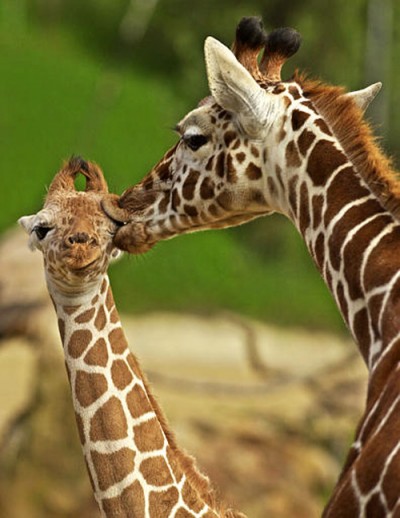It's All About Giraffes, Baby!
Reproductive
behavior in giraffes is known to occur throughout the year. Females reach maturity at age four while
males mature by age seven or eight. Males will migrate to different herds
seeking females in estrus, or “in heat,” to mate with. Giraffe reproduction occurs through a
multistep process called Flehmen response. This courtship begins when a male approaches a female from
behind a nudges her hind leg, causing urination. Once the female begins to
urinate, the male will drink the female’s urine to determine if she is in
estrus. The male can detect this by the taste of the urine. Once the male has
decided the female is in heat, he follows her until she allows
him to mount her. Once conception has occurred, the female carries her calf for
approximately fifteen months! Females typically give birth to one calf at a
time, and remains alone with her calf for about a week to provide protection
against predators. After birth, a newborn is between 5’6 and 6’6 feet tall,
weighing 104 to 22o pounds!
http://cute-n-tiny.com/cute-animals/mom-and-baby-giraffe/
Most reproduction in giraffes is polygamous,
meaning that a few older males mate with all the fertile females. Usually male giraffes prefer younger
females because they are in heat more often than older giraffes. In contrast,
females prefer older males as mates. If a dominant male senses that another
male might be trying to approach his female during courting (sexual) behavior,
he will stare the other down until he leaves. Females allow this behavior to occur
because they want to mate with the dominant male for as long as possible,
however no long term bonds are formed between male and female. Giraffes will
sometimes participate in homosexual behavior, but it mostly occurs with males.
Fun Fact of the
Week: Females give birth standing up, so their calves experience a 6 foot drop
to the ground! Newborns are not harmed, and are able to stand within a half
hour.
Works
Cited
Alex. "30 Strangest Animal
Mating Habits." Neatorama. 30 Apr. 2007. Web. 26 Feb. 2012.
<http://www.neatorama.com/2007/04/30/30-strangest-animal-mating-habits/>.
"Giraffe Fact Sheet." Welcome
to the National Zoo. Web. 26 Feb. 2012.
<http://nationalzoo.si.edu/Animals/AfricanSavanna/fact-giraffe.cfm>.

Wow! I can not believe that they baby literally just falls to the ground, it almost looked like the baby was not alive when it was born! That video clip was very intersting, never seen a live birth of a giraffe before! I wonder if the "Genetic Memory" that the giraffes have regarding the time it takes for a baby to learn to stand will someday be longer for those breed in captivity since it is not a threatening environment?
ReplyDelete